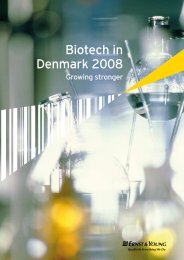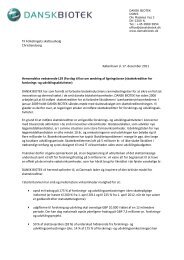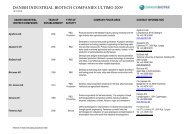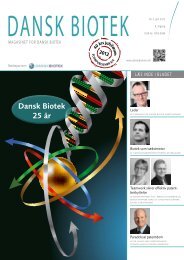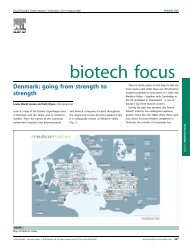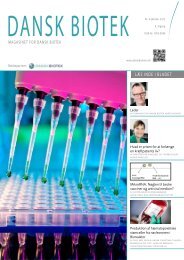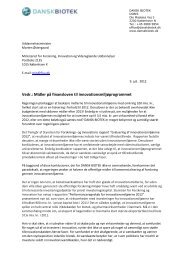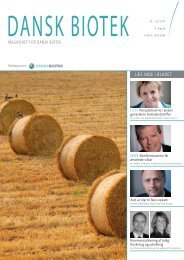Klyngepolitik på et faktabaseret grundlag - Dansk Biotek
Klyngepolitik på et faktabaseret grundlag - Dansk Biotek
Klyngepolitik på et faktabaseret grundlag - Dansk Biotek
You also want an ePaper? Increase the reach of your titles
YUMPU automatically turns print PDFs into web optimized ePapers that Google loves.
FORA RAPPORT KLYNGEPOLITIK PÅ ET FAKTABASERET GRUNDLAG<br />
tive analysis of the survey data to identify factors related to good productivity performance<br />
for life-science firm. The distribution of all firms in the region compared with the distribution<br />
of firms in the survey sample show that the sample is an unbiased sample of all life science<br />
firms in the selected regions, cf. Table 3.1.<br />
Table 3.1 Distribution of firms according to size across regions<br />
Potential firm matches Actual firm matches<br />
Large Medium Small Total Large Medium Small Total<br />
Copenhagen 0% 41% 38% 15% 56% 41% 7% 13%<br />
Kiel 62% 13% 10% 20% 6% 0% 1% 2%<br />
Helsinki 0% 13% 16% 15% 6% 9% 23% 20%<br />
Stockholm 13% 18% 25% 31% 22% 38% 44% 42%<br />
Malmö 15% 3% 7% 10% 0% 6% 11% 11%<br />
Gothenburg 10% 13% 4% 10% 11% 6% 14% 13%<br />
Total for size 100% 100% 100% 100% 100% 100% 100% 100%<br />
Note: Potential matches are firms we identified in the regions while actual matches are firms for which we have<br />
collected responses in the survey<br />
Source: Copenhagen Economics and BSR Life Science Survey<br />
This shows us that we have a large random sample of firms, thus allowing us to use descriptive<br />
analysis of the survey data. Linking with the estimates of firm performance on productivity<br />
reveals some striking results.<br />
High innovation activity is positively linked to productivity. Innovative life-science<br />
firms have, on average, higher productivity than the less innovative life-science firms.<br />
Innovative firms collaborate more. We have shown that the most innovative life-science<br />
firms also collaborate more with local partners within the region were they cluster. The<br />
innovative firms collaborate more than their less-innovative neighbouring firms in the<br />
same regions. This indicates that there are local innovation spillovers b<strong>et</strong>ween firms that<br />
positively impact on innovation and in turn on productivity.<br />
Cluster framework conditions matter for innovation and collaboration. Not only does<br />
the most innovative firms collaborate more with local partners within their cluster region,<br />
they also value the quality of the local framework conditions more. There is high<br />
level of inter-firm collaboration when there are good framework conditions, thus cluster<br />
policies seems to matter for innovation and collaboration and through those channels<br />
leading to higher productivity.<br />
These results enable us to reaffirm that firms who invest in innovation have higher multifactor<br />
productivity. From the innovation activities, these firms are able to produce and earn<br />
more than less innovative firms with similar size of workforce and production factors, and<br />
the productivity of innovative firms is on average higher than less innovative firms.<br />
12<br />
S.122



